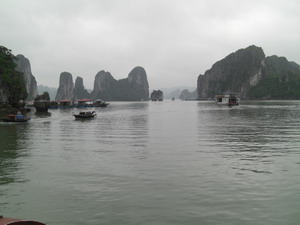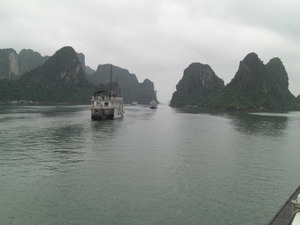April 18 - 25, 2014
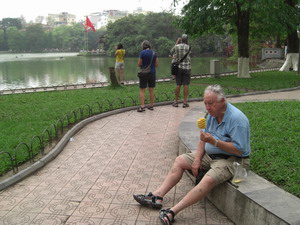
On our Australian trip we had a stopover in Hong Kong and decided to
fly to Vietnam to spend a few days there. By the time we reached Hanoi
it was dark.
As we peered through the taxi window at the muddy streets without
pavements,
strange narrow houses, people sitting by the road on plastic chairs and
throngs of mopeds,
I became more and more apprehensive about our hotel. I promised myself
not to
pull a face and not to complain about having to schlep my suitcase up
the
staircase.
Well, we found ourselves at Hotel De l' Opera,
a most pleasant hotel where they upgraded us to a huge suite for the
night.
Dinner was good and we were served by a delightful waitress who every
day, even
when not serving our table, rushed over to give us our morning cups of
tea and
coffee.
The next morning we walked to Lake Hoan
Kiem where Eitan ate an artisically cut pineapple and where we
watched a game that seemed a
cross
between golf and bowls played with a golf club and a badminton
shuttlecock instead of a ball. We visited
the Ngoc Son Temple in the middle
of the lake. We then braved the traffic, hesitantly threading our way
through an
unending swarm of mopeds, speeding along like drones of angry hornets,
not even
thinking of slowing as we crossed in the pedestrian crossing.
The rest of the day was spent walking the
streets. We were surprised at the number of shops selling Northface
clothing
and backpacks.
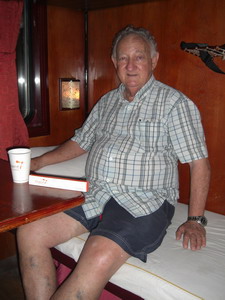 That night we took the night train to Lao
Cai. Although the mirrors on the train, the paper cups and the
toothbrushes all
had “Orient Express” emblazoned on them, it was anything but. We had
booked a
luxury cabin which we had to share with two other passengers. To my
horror
there was no ladder to climb to the upper bunk, only a narrow ledge
that
I could
not negotiate. I remembered my mother and her friend who were on a
night train
many years ago in Russia, in what must have been a similar compartment.
When
two men entered to share the compartment, my mother forcibly pushed
them out
into the corridor and locked the door. No amount of shouts and threats
from the
men and the woman in charge of the carriage could persuade her to open
the
door.
That night we took the night train to Lao
Cai. Although the mirrors on the train, the paper cups and the
toothbrushes all
had “Orient Express” emblazoned on them, it was anything but. We had
booked a
luxury cabin which we had to share with two other passengers. To my
horror
there was no ladder to climb to the upper bunk, only a narrow ledge
that
I could
not negotiate. I remembered my mother and her friend who were on a
night train
many years ago in Russia, in what must have been a similar compartment.
When
two men entered to share the compartment, my mother forcibly pushed
them out
into the corridor and locked the door. No amount of shouts and threats
from the
men and the woman in charge of the carriage could persuade her to open
the
door.
Thankfully the other couple
who shared our
compartment agreed to take both upper bunks and I didn’t have to resort
to
violence.
The train left exactly on time…. but
arrived 4 hours late.
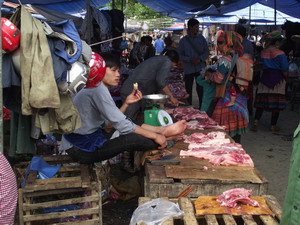
We were met by a
guide and driver and after a miserable breakfast were driven to the
Sunday
market at Bac Ha.
Despite the absence of refrigeration were struck by
the absence of flies – a sharp change from the previous week when in
the Red
Center. (There was no absence of bare feet on the tables next to the
meat!).
The market takes over the whole village and is most colorful,
especially due to the traditional clothes that the various H’Mong
ethnic tribes
wear. The most interesting part was the animal market – horses, huge
buffalo
lounging in the sand; puppies playing between the sellers legs (food or
pets?),
pigs and various birds. Tight groups of men examined every feather and
feature
of fighting cocks while others sat on their haunches in front of rows
of
singing birds in beautiful bamboo cages listening and evaluating their
songs.
On
the way to Sapa, where we were to spend the next two nights, we drove
along the Red River, passing a bridge that lead into China. We
also stopped
to walk
through a green tea plantation in a beautiful valley.
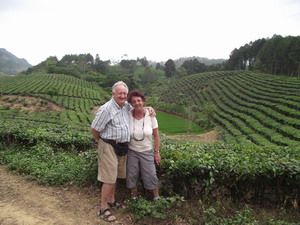
Vietnam was a bit of a puzzle to us. Ostensibly it is a
communist state, but there is free enterprise. Urban citizens
have to pay for
all medical and educational needs, while ethnic tribes in the outlying
areas get free education and medical services and are also allowed to
have three children without a penalty - all in an effort, it seemed to
us, to encourage them to remain in the villages and in rice production.
Although our various guides were
reluctant to speak about it, we understood that in a one-party state
there is
little redress for grievances or change. And corruption is rife. Not
long after
we left Bac Ha we were caught in a traffic jam. Workers building a new
bridge
had ploughed up the tarred road and made a narrow unsealed detour. We
were at
standstill for over 40 minutes while cars and scooters continually came
from
the opposite direction, not allowing our lane to pass. When we asked
where were
the police to direct the flow of traffic we were told that there was no
money
in this and they wouldn’t come. Eventually we persuaded our guide to go
and do something;
otherwise we would have been there until the next morning when they
widened the
road!
When we arrived at Sapa, again in the dark,
it was shrouded in mist; in fact although our hotel room would suggest
we were
above a valley we never saw it.
The next morning we were happy not to have
to walk the 13 km hike down the mountain and did a shorter route
instead.
We were
finally below cloud cover and an enchanting valley sculpted by unending
terraces of rice paddies opened up below us. Here in the mountains
because of
the cold, the villagers can only grow one rice crop a year. Most
terraces were
mud or water waiting for the rice shoots to be big enough to be
transplanted.
Springs filled an upper level of terrace and the water then flowed into
the
ones below. They use buffalo dung for fertilizer and each shoot has to
be
planted by
hand. Where the ground cannot be flooded we saw maize and beans.
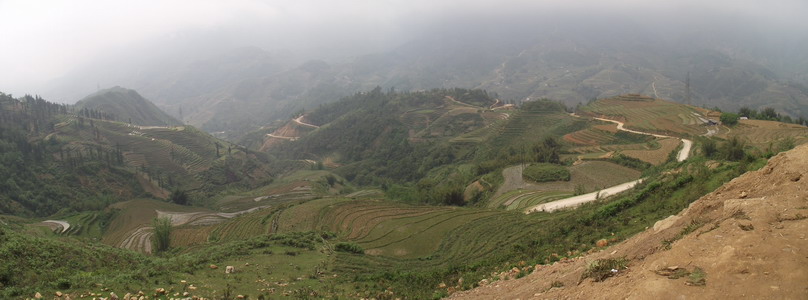
Lunch was a delicious noodle soup, well-earned
after continuing to descends to another village in the area. After
lunch we were happy
to be
transported back to Sapa. After a good
supper we too investigated the Northface, Columbia and Kipling labels
offered
at nearly every store.
The following morning we hiked down to Cat
Cat village. It was described as an easy 4 hour hike – nothing is easy
when
you are
walking downhill all the time! Eitan and I are like Jack Sprat and his
wife.
He does the downhills okay, which are painful for me and I sail the
uphills which are somewhat of a struggle for him.
By the waterfall at the bottom of the
valley we saw a delightful folkdance show and so as not to embarrass
our guide
I agreed to do a dance hopping between bamboo poles. I was embarrassed.
We
ended the day with a steep walk up to Sin Chai village and then back to
Sapa
and the night train to Hanoi. A delightful three day stay.
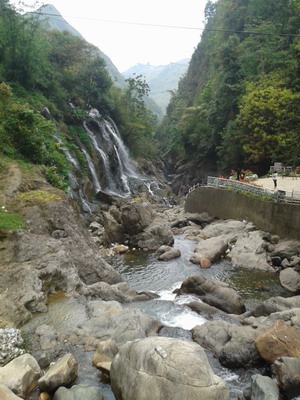
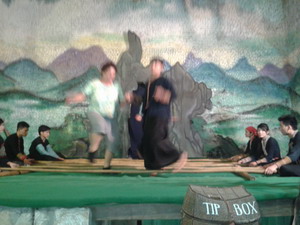
Doreen dancing the bamboo dance (apologies for the
blurred picture)
We had signed up for a
cooking
class at the Hanoi Cooking Class on the
other side of town. As our
taxi threaded its way through the morning traffic, looking at the
mopeds sometimes transporting two parents and two children, I was
reminded of our own early days in Hofit when we had a Vespa. With Vered
on the backseat and Aviv standing between my legs we would drive from
Hofit down to the beach and think nothing of it. At
the cooking school another family was
already
there sipping their liquorice tea. They were from Australia; the wife’s
mother,
an immigrant from Indonesia
had opened the first Asian restaurant in Sydney;
so they were much more familiar with Asian cooking than we.
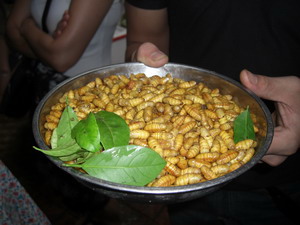
We
started the morning with a walk through the market where our
guide and teacher Chien identified the various herbs and vegetables. He
bought
some prawns that we would later prepare in class. We stopped by a stall
that
offered chicken, quail and duck eggs .Eitan and I declined the chance
to
later eat the embryo of a duck egg, but the other family readily
agreed. Chien
took two eggs and held them up to the overhanging lamp. One was clear
and the
other opaque – that was the fertilized one
I thought of my father (Grandpa Maurice) who always wore thick
green gl;asses. He said he had ruined his eyes at
his first job in South Africa. His uncle (uncle Joe Glasser)
had paid
for his passage from Vilna, via Southampton, to Capetown and then
across land
to Johannesburg. His family had operated an inn back in Malat near Vilna, so he went to work in a grocery
store. His first job was to sit in the basement of the store and take
each egg,
hold it up to the candlelight and make sure it was
clear and therefore kosher.
Our
last stop was by a plate of squirming grubs. Not wanting to
appear a wimp I said I would eat them and we added
this to our menu for later.
Back
at the kitchen we had
to wash our hands and don an apron. The kitchen had a number of
stainless steel
tables, some of them full of local students who were preparing for a
function.
Chien demonstrated how to prepare the food and then we returned to our
table
and tried to follow his instructions:
“Do we have to add the fried shallots to the salad or the dressing?” . “Make sure to dissolve the sugar in the
rice wine before adding the fish sauce, otherwise it will separate.” I was reminded that on Massada by the Dead Sea
archaeologists found a ceramic jar from the time of King Herod that had
the
remains of a pungent fish sauce imported from Europe. It was the
ketchup of its time. We always think
of Asian
food as having soy sauce. In Vietnam we hardly saw soy sauce, the
condiment of
choice was always fish sauce, used in cooking and in dipping sauces.
We helped prepare noodle
soup which we immediately ate. The broth was made from roasted meat bones that had been simmered
for 8 hours with various spices.The secret to it remaining clear was
not to let it boil but keep just at simmering point. It was good, as
good as the noodle
soup we had
eaten the night before, sitting on the pavement in Lao Cai before we
boarded
our train.
We
also prepared green papaya salad, learnt how to quickly julienne
green papaya and sweet potato with a special peeler (that we later bought) as well as using a traditional wooden
one, which Eitan said was just as efficient. We prepared rice wraps
with beef
and vegetables. Finally we prepared the binding sauce for prawn and
sweet
potato pancakes, and made banana and coconut cream pudding for desert.
We
watched as Chien broke open the duck egg
that had been boiled for 30
minutes and then with chopsticks carefully peeled away the yolk sac and
chopped
up the tiny duck embryo. Again we politely declined the offer to taste.
Then
came the turn of the grubs. They were tossed into a hot frying
pan, some still squirming and after being pan roasted Chien added some
chilli
and soy oil. He apologized for pouring too much oil into the pan. We
were then
invited to take chop sticks and tuck in. Actually, if you could
overcome the
thought of what you were eating they were tasty, but after a few I
could
happily say: “Delicious, but too oily for me.”
We
ended the morning by sitting on the rooftop of the school and
enjoying the food we had prepared. A delightful morning.
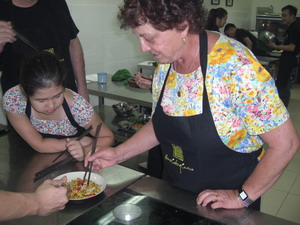
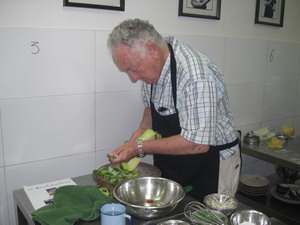
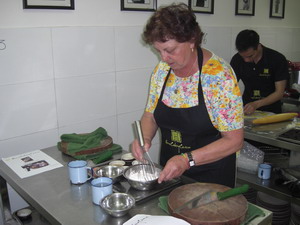
In
the evening we went to the Water Puppet Show, without great
expectations except that we remembered our granddaughter Dani telling
us how
much she had enjoyed it. The hall has a
pool bordered by a raised dias with an orchestra and singers and a house
in the water with flaps.
The
beautifully fashioned wooden puppets -
people, fish, a fox, dragons and
butterflies - were brightly coloured and lacquered.
We were fascinated by the movements of the puppets in
the
pool as they enacted folk tales with charm and humour. The orchestra
and
singers accompanied each scene often
warning the puppets of impending danger. We could not fathom how
the
puppets could move and twirl and flip backwards and forwards. It was
delightful. After the performance the puppeteers, wet to their waists
appeared.
Later we found out that the water puppets originated 1,000 years ago in
the
rice paddies in North Vietnam – in the very area that
we had visited, at this time of year
when the rice paddies were being flooded and before the planting began.
The
puppeteers hid behind the terrace and moved the puppets with bamboo
rods and
levers. They still use the same technique today. Well recommended!
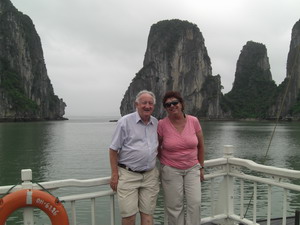
The
next morning we set out to Halong Bay (a World Heritage Site) in the
Red River Delta. Only 160
kms from
Hanoi it took as long to get there as the
350 Km
drive from Netanya to Eilat because of traffic and bad roads. On the
way we
stopped at Hai Duong Toon, a complex that offers a home and a
sheltered
workshop to children suffering the effects of Agent Orange sprayed on
their
parents and grandparents during the American-Vietnamese war. Many of
the young
people suffer severe birth defects and many are mute. But talented they
are and
have been taught skills such as weaving, embroidery, painting and
sewing. It
was a pleasure to buy the few souvenirs we needed from a sheltered
workshop.
At
Halong Bay we were faced with tens of large boats in the dock,
and looked for a small boat for the two of us.
In the end we had a large boat to
ourselves
and enjoyed a delicious seafood lunch as the boat slowly sailed out to
the
enormous bay encircled by rows and rows of
the huge limestone cliffs jutting out the sea. The quiet and magnificent scenery was so relaxing.
